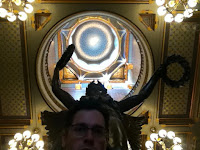Predictions/Inquiries:
- There
will be a focus on Castine’s role in the Revolution.
- Other
than Castine’s Revolutionary history, what else is there to know?
- How
does the Castine Historical Society compare to others that I’ve visited in
their presentation of material and their points of emphasis?
- How
are Castine’s values reflected in the historical memory cast in the Historical
Society’s presentation/s?
At the Museum:
The
Castine Historical Society is an incredibly well put together museum with two
permanent exhibits and another section that changes yearly. This museum does it right in terms of having
a clear purpose, deliberate organization, aesthetically appealing presentation,
relevant imagery, and the use of both primary and secondary sources, that in effect
encourage visitors to engage with the material, raise questions, and interpret
for themselves.
While
the exhibit on Castine’s Revolutionary history was equally well done, most engaging
was this year’s rotating installment titled Castine’s
Devoted Women: Partnership and Social Reform 1910-1962. The exhibit focused on the impressive and
interesting lives of former residents Polly Porter (1884-1972) and Molly Dewson
(1874-1962). The exhibit came together
after a twenty-eight volume scrapbook collection, put together by Porter and
Dewson, was donated by a relative last summer. CHS creatively presents the
“exhibit in the style of a scrapbook, telling the story through the words and
eyes of Molly and Polly.” As CHS notes,
“The goal is to present each aspect of their life and work through quotations
from their correspondence, contemporary newspaper articles clipped and passed
into the pages of their scrapbooks, and the worlds of those who new them.” Further, CHS seeks to impart interpretation
on viewers but instead encourages each visitor “to read the Porter-Dewson’s
life story on his or her own terms.” The
thought, care, and attention to detail that went into this beautifully
constructed exhibit is visible throughout.
The aesthetic design of the displays, for example, goes as deep as the
backdrop which was inspired by the “grasscloth wall coverings in the dining and
living rooms” of the couple’s Castine house. Altogether, the inviting and interactive
approach weaves an intimate narrative of these two extraordinary people.
 Both
women lived full lives and contributed much through their local, national, and
global efforts. They were both involved
in feminist politics and Progressive social reform for the duration of their
lives. During World War I, both women joined
the Red Cross and traveled to France where they worked with refugees. However, it is Molly who left the most
significant legacy. Even before the War she
had established a name for herself and was asked by Jane Addams to deliver a paper
at a conference of the Committee on Immigration. During
that time, her efforts focused on workers’ rights as she worked directly with
women laborers while also pushed for state and national legislation. Both women developed a strong relationship
with Eleanor Roosevelt who visited them several times in Castine, sometimes
with Franklin, and who the Porter-Dewsons visited at the Roosevelt summer
estate on Campobello Island. Molly was
recruited to work on FDR’s gubernatorial campaign in the twenties and later his
presidential campaigns. She was credited
in a 1933 Boston Globe article that read: “Ms. Dewson’s hand ran the machine
that brought women to the polls to vote the Democratic ticket.” The article went on to note that “for the
first time on any wide scale the party organization of women was begun from the
bottom up in precincts and counties, along the same lines as the organization
of male voters.” Interestingly, as the
Spring 2017 CHS Newsletter points out, Molly’s work on FDR’s campaigns was
inspired, using the tactics of the women’s suffrage movement to reach voters on
a local level.” Molly’s legacy is
perhaps best captured by Eleanor Roosevelt who said of Dewson that “No other
women has ever done so much to advance the stature of all women in politics.”
Both
women lived full lives and contributed much through their local, national, and
global efforts. They were both involved
in feminist politics and Progressive social reform for the duration of their
lives. During World War I, both women joined
the Red Cross and traveled to France where they worked with refugees. However, it is Molly who left the most
significant legacy. Even before the War she
had established a name for herself and was asked by Jane Addams to deliver a paper
at a conference of the Committee on Immigration. During
that time, her efforts focused on workers’ rights as she worked directly with
women laborers while also pushed for state and national legislation. Both women developed a strong relationship
with Eleanor Roosevelt who visited them several times in Castine, sometimes
with Franklin, and who the Porter-Dewsons visited at the Roosevelt summer
estate on Campobello Island. Molly was
recruited to work on FDR’s gubernatorial campaign in the twenties and later his
presidential campaigns. She was credited
in a 1933 Boston Globe article that read: “Ms. Dewson’s hand ran the machine
that brought women to the polls to vote the Democratic ticket.” The article went on to note that “for the
first time on any wide scale the party organization of women was begun from the
bottom up in precincts and counties, along the same lines as the organization
of male voters.” Interestingly, as the
Spring 2017 CHS Newsletter points out, Molly’s work on FDR’s campaigns was
inspired, using the tactics of the women’s suffrage movement to reach voters on
a local level.” Molly’s legacy is
perhaps best captured by Eleanor Roosevelt who said of Dewson that “No other
women has ever done so much to advance the stature of all women in politics.”
Interestingly,
it wasn’t until after I left Castine and read the Historical Society’s
newsletter that it dawned on me that Molly and Polly were more than friends and
colleagues. Though neither the
Newsletter nor exhibit explicitly reveal the two’s romantic relationship it
seems clear reading between the lines.
That’s one thing that I would have liked to have learned more
about. How were they received and
perceived in their lives whether it be in France, NY, Boston, or Castine? Given the taboo of a homosexual relationship
in the time period in which they lived, how did they deal with it, how did they
act, how did they present themselves, how did it impact their careers, how did
it affect who they surrounded themselves with, were they public about their
relationship? I imagine that there is an interesting story to tell along these
lines. I guess it’s to the credit of the museum to avoid what would certainly
bring a different focus to the exhibit. One
interesting approach might have been a second exhibit that acts as a
juxtaposition that follows the same narrative but tells a different story about
Porter-Dewson along lines of gender and sexuality. Even without this likely
deliberate omission, Castine’s Devoted
Women is as good as it gets in terms of historically focused museum
exhibits.


















































